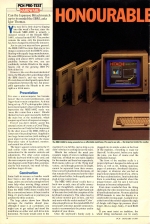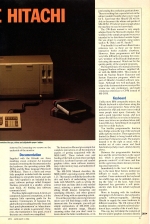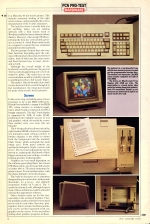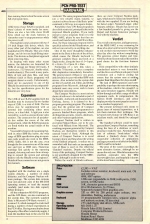
Personal Computer News
 14th January 1984
14th January 1984
Author: Igor Thomas
Published in Personal Computer News #044
Honourable Hitachi
Can the Japanese Hitachi match up to its model the IBM, asks Igor Thomas
You may feel a little deja-vu slipping into this week's Pro-test, since the Hitachi MBE-16002 is actually a matured version of the Hitachi MBE-16001, released in mid-1983. The product remains the same, only the presentation has been changed to protect the innocent.
Just in case you may not have guessed, the MBE-16002 has more than one or two things in common with the IBM PC series. Starting with equally large manufacturers, the same 8088 processor in the middle, and ending with almost 100% software compatibility between the two, you can confidently include Hitachi in the single-figures end of the growing IBM PC lookalikes list.
However, like even the most identical of twins, the Hitachi offers some things which the IBM doesn't, and vice versa. This Pro-test does not dwell greatly upon direct comparisons between the two, but principally approaches the Hitachi in its own right as a 16-bit micro.
Presentation
For once a microcomputer has become *heavier* than its recent predecessors, and *bigger* than its main competitors. As it was being set up, PCN's photographer (also a keen micro hacker) observed that the first impression the MBE-16002 made was "more like a mini than a micro". Hitachi themselves have quite inscrutably dubbed the main box as the mainframe, which conjures up all sorts of impressive images.
Even if you don't entirely accept this unusual course of events as a Good Thing, your muscles can't help but feel impressed by the sheer mass of the MBE-16002 as it comes out of its packing boxes. Supplied in two large brown cartons (with nothing of great import on the outside) is the classic three-piece suite of keyboard, monitor, and central box of tricks.
The larger, squarer carton carries the 13" colour video monitor, cable, and instructions for the monitor controls and adjustments. The other carton contains both the keyboard with its curly cord, and the main computer proper. The packaging also disgorges some floppy disks accompanied by four manuals, one small A5-size, and three larger A4-size.
Construction
Some built-in recesses as handles would have been a nice idea at the setting-up stage, unless you are lucky enough to have some help when moving things around. Suffice it to say, portable this micro is *not*. Since the MBE-16002 doesn't really look like a conventional micro, if there is such a thing, it's pretty much up to you how you position the three sections.
The large photo shows how Hitachi envisages the machine should pose, although if space is at a premium, you might care to get radical and stand the mainframe on either end, with drive slots horizontal. No harm would come to the machine if you did this, just as long as you didn't obstruct its cooling fan (at the rear).
Hitachi has reduced the usual prerequisite tangle of wires to nothing more than four, of which two are mains supplies for the monitor and brain box respectively. Both mains cables are of the "flying lead" variety, and although generous in length, cannot be separated from their owners. Once correctly plumbed into the mains, all that remains to be connected are the video and keyboard cables, both equally painless push-in type connections.
The MBE-16002 doesn't really have a back view as such, since all cable connectors are thoughtfully collected into one single compartment on the right-hand side of the main box (with the exception of the keyboard connector). The video lead to the colour monitor goes in here, and will only mate with the socket marked 'Color'. Also situated here are the standard RS-232 serial and Centronics parallel connectors, ready to accommodate the printer and/or modem of your choice.
Once the keyboard's hunky curly is plugged into its simple socket on the front of the machine, everything is ready for blast-off. At this point, before you apply the juice, you have of course read the instruction manual.
The front of the machine really is a proper clipboard, designed to slide up and down, as well as tilt, holding numerous pages of printouts, shorthand dictation, rice paper, or whatever else you feel an urge to keep clipped in front of you. After a few days acclimatisation, I must admit that there is something wonderful about this unique feature, and I'm sure it will soon threaten to become indispensable.
Even more wonderful than the tilting clipboard, the video monitor has a built-in tilt and lock mechanism. No more piled-up CP/M manuals to raise the display to a comfortable viewing angle. A simple lever at the front of the monitor adjusts the angle of dangle with finger-tip pressure (don't forget, this is a large, bulky, 13" RGB rig).
If you must insist on tradition, the whole tilting mechanism can be easily removed by loosening two screws on the underside of the monitor.
Documentation
Supplied with the Hitachi are three matching cream coloured A4 looseleaf manuals containing the documentation for the hardware, the operating system (MSDOS), and the Basic language (Microsoft GW-Basic). There is a short and sweet little pamphlet included with the monitor describing its retractable knobs and such like. Also supplied is an "included in the price" software package called Compact Nucleus, presented in a smaller, serious matt black, A5 binding (See software comments later).
The three lightweight cream A4 texts are completely Japanese conceptions, as is the separate little operating guide for the monitor. Connoisseurs of Japanese English will enjoy reading about the 'front and back porch phenomenon' or 'when abnormal odour or smoke is generated'. However, the transaction is very good, even if the texts are a touch over-simplified.
The Instruction Manual gives simple but complete instructions on all the important aspects of getting acquainted with the MBE-16002. These include care and feeding of the built-in clock (three penlight batteries), keyboard layouts and symbol graphics tablets, main software memory map, video memory map, and rudiments of floppy disks.
The MS-DOS Manual describes the MBE-16002's operating system, MS-DOS 1.25. The manual confidently describes the dos and don'ts of undertaking 'system' tasks with MS-DOS, such as setting the correct time and date (this is only needed once), selecting a printer, enabling/disabling RAM disk(s), formatting and cataloging diskettes, and other general chores of living with an operating system.
It is at this point that a more experienced micro user will findthings a trifle on the innocent side. For example, you only get simple explanations of MS-DOS commands and memory usage, Hitachi assuming either that you don't want to jnow about the fuller ramifications, or its just keeping the confusion quotient down. There is nothing that a specialist text on the subject couldn't handle when you're ready for it. I just hope that Hitachi UK will be able to document the whims and quirks of MS-DOS 1.25 before I learn enough about the machine to need to know them.
The GW-Basic manual is very simply adapted from the Microsoft original. One wonders if the sample programs were ever intended to be distributed outside Japan. Do you object to examples using names such as 'R. Okita' and 'H. Suzuki'?
You shouldn't try and learn Basic from a reference text, as there are far better instructive books available elsewhere. However, Basic programmers will find very little difficulty in learning the necessary "wrinkles" of the Hitachi implementation using this manual. Watch out for the quirky quality of the example programs.
The fourth (black A5) manual covers the Compact Nucleus software, supplied "all-in" with the MBE-16002. This consists of both the Nucleus Report Generator and System Generator programs, which are part of Hitachi's branded software catalogue. Although very well packaged, the copy of the documentation we received for review was only preliminary, and made erroneous references to CP/M instead of MS-DOS.
Keyboard
Unlike most IBM compatible micros, the Hitachi keyboard is styled more along the lines of a real typewriter. None of the silly positions for shift and return (enter) which some people insist upon. Curiously, for such a good typewriter layout, shift lock causes the shift key to reverse its function; lower case letters are produced when shift is used this way. Something of an acquired taste for us older hackers.
Ten healthy programmable function keys bridge across the top of the keyboard alpha (qwerty) section. These appear to be limited (in Basic) to being loaded with no more than 15 characters each. The numeric keypad is to the right as usual, with a modest set of extra cursor and fixed function keys (help, insert, delete) directly above.
Between the programmable function keys, and the extra fixed keys is the cancel key, which is presently configured to generate CTRL-C at all times, and thus merits a generous plastic shroud, preventing casual operation.
Immediately to the 'rear' of the cancel key is the main Reset button; neither too difficult to reach, nor accessible by accident. From underneath the keyboard two stubby legs can be unfolded, improving the 'rake' of the keys. And every depressed key generates a soft piezo-electric click from the inbuilt keyboard sounder.
More in keeping with the traditions emerging in 16-bit micros, the keyboard is actually software-mappable, allowing Hitachi to supply the same hardware to different countries. The UK release of the machine includes a suitably tailored selection of keys, notably of the # and £ keys.
The copy key will dump the contents of the text and/or graphics screen(s) directly to a Microline 84 dot-matrix printer. This includes automatic shading of the eight screen colours, and presumably the correct interpretation of the # and £ characters.
The help key doesn't actually help you do anything, unless you are running software with a help system (such as Wordstar) which has been educated about this key. However, when using GW-Basic, pressing the help key conveniently generates a CTRL-A, which Basic understands as a request to repeat the last command entered from the keyboard.
The two groups of cursor keys also vary their functions depending upon the software of the moment. Basic has two forms of editor, both of which use the extra cursor and fixed function keys to insert, delete, and so forth.
Although the overall weight of the keyboard is sensibly generous, the general 'feel' is feally disappointing; not very lively would be polite. The return key on our review machine would not reliably respond to anything less than a full 'karate' finger.
The truth is, Hitachi shouldn't have built its own keyboard from scratch though it in fact manufactures the integrated circuits for many of the world's best keyboards.
Screen
In the centre ring, we find the piece of least resistance as far as the MBE-16002 goes. Hitachi has included a snappy 4-bit RGB TTL colour monitor as standard equipment, which would cost upwards of £500 if bought separately. The big 13-inch display is supported by 192K of video RAM, partioned into multiple screens of text and graphics, which also would be a more than modest extra cost were this not Hitachi!
The 4-bit specification allows each of the eight standard RGB colours to be assigned two intensities under software control. A further elegance is the ability to colour both the background and the normally black 'frame' which surrounds the main image area. Front panel controls are spartan but adequate: bright, contrast, and power. The two knob adjustments may be moved in, reducing the likelihood of little fingers messing up your settings, as well as looking sprauncy in photographs.
Graphics are very much dependent on the software generating them, but at least GW-Basic allows you to create full screens of either 640 or 320 pixels horizontal by pixels vertical. Text is another matter, with the choice limited to 40 or 80 columns.
The built-in character set is somewhat disappointing in construction, with pseudo descenders on g.j.p.q.y. and similarly economical bodies on b and d. The + symbol is extremely odd, although I expect most of these definitions could be altered if one had the appropriate software.
Other benefits make up for this loss, especially in the writing of graphics. First, the multiple graphics and text screens need not be tied to each other; they may 'play' together, but in a stroke of software genius, text can be scrolled separately from any graphics on the screen. It was marvellous writing short graphics programs in Basic, then running them behind the same screen full of program lines.
Storage
128K bytes of user RAM is standard, and there's plenty of room inside for more. There are also a few little clever RAM bytes which use the clock batteries to remember you i/o setup parameters while the power is off.
The machine comes complete with two 5.25" floppy disk drives, which, like every other part of the machine, are also manufactured by Hitachi. They are of slim design, and do not use head-lifting interlocks. This dictates a disciplined approach when removing disks.
In keeping with many other recent micros, the diskettes are formatted for 320K of storage per floppy (40 tracks, 8 sectors per, 512 bytes per, double-sided, double-density). The result is easy portability of text and data files, and most software (such as Basic programs) will emigrate almost as easily. Unfortunately, there are no guarantees in any of the Hitachi documentation about compatibility, but the specifications given for the diskettes are very clear.
Expansion
The 128K of user RAM supplied with the machine may be increased in two further steps of 128K, to a total of 384K. The two drives may be supplemented with an external unit containing either more drives, or a hard disk. A light pen is also catered for, as well as a monochrome video monitor. The connectors for all peripherals live within the recess of the side compartment, while the RAM expansions are fitted within the actual insides of the machine.
You could be forgiven for assuming that, with its other IBM-like habits, the wide range of IBM specification plug-in expansion cards would also work in the MBE-16002. Sadly, this is not the case, even though the five connectors are of the same size and type as IBM ones. Numerous warnings lurk quietly in the operating manual, deterring end users from attempting to expand the system and advising them to "ask the Hitachi service engineer". Details of these connectors are not given in the manuals.
Software
Supplied with the machine are a single system diskette, a number of demo diskettes, and the Compact Nucleus software package. The system disk contains your one-and-only copy of the MS-DOS operating system, so read the manual carefully (and make two disk copies!) before diving in.
All the companion MS-DOS programs, and the GW-Basic, are also contained on the system disk. The currently supplied Basic is Microsoft GW-Basic version 1.5, revision 2.0, which managed to crash itself during a number of short experiments in the PCN office. Having some doubts about the purity of the office's electricity supply, I took the machine back to the cave for the weekend. The same programs failed there (on a very reliable mains system), so caution is advised in use of the Basic 'paint' command to fill large non-square shapes.
Portability of any GW-Basic programs is also a little restricted, principally due to the improved Hitachi graphics. If you really intend to move programs from or to the MBE-16002, please be sure that they are saved (and transferred) as ASCII text files. Also, the Basic language program itself is specifically tailored to the Hitachi micro, and will not run correctly on anything else.
One of the more thoughtful enhancements to the Basic is the use of the alt key, which causes the Hitachi keyboard to generate complete Basic keywords at a single stroke, along the lines of: I = Input, G = Goto, O = Open, R = Run.
Formatting of a new disk takes a tolerable 70 seconds, as does a complete disk duplication immediately thereafter. The general speed of Basic is very good, and certainly on a par with other IBM-style micros. Also included on the system disk are the very useful Link, Edlin, and Debug programs from Microsoft, although non-technical users may never wish to learn about their convolutions.
The Compact Nucleus is a most curious choice of software to be included as part of the bundle. Authored and documented in Dorking, Surrey, it is claimed to be a program generating program. The manual says that the general aim of Compact Nucleus is to allow non-programmers to generate finished Basic programs, which do things like accounts, reports, databases, and other business applications.
Compact Nucleus itself is written in encryted Malard Basic, not to be confused with MBasic from Microsoft. The resulting programs generated by Compact Nucleus are themselves written in this unusual brand of Basic. Although the intent of Compact Nucleus is to avoid having to know anything about the writing of the finished program, it strikes me as somewhat odd that such an incompatible type of Basic is used on this otherwise 'standard' machine. Despite the official livery of the packaging, Compact Nucleus is not specifically designed for the MBE-16002, although it seems to work.
Within the world of Hitachi software, there are more Compact Nucleus packages, which may be linked and intertwined with the two supplied. If you are looking for Sales Ledger, Nominal Ledger, other business software, Hitachi has saved you a few hundred pounds by giving you the Report and System Generator packages free with the machine.
Verdict
The overall construction, and appearance, of the MBE-16002 is very reassuring for those of us who look forward to being able to rely on their microsystems to work day after day after day without complaining. The generous colour display and typewriter keyboard layout makes this system a good choice for the first-time business user.
Disk compatibility with other similarly standardised micros is very favourable, and the drives are efficient and quiet. Good ventilation and a built-in cooling fan ensure that the system runs at nothing greater than blood-heat for days on end.
The lack of IBM expansion card compatibility is perhaps the main shortcoming of the machine, which is fair enough if, as the sales literature suggests, Hitachi will follow through and offer a range of official expansion cards. In compensation, the built-in RAM interfaces, and colour display provide the most popular accessories as standard equipment.
The present keyboard only seems to please users of manual typerwriters, as it lets them maintain their technique. The keyword entry feature in GW-Basic is an excellent touch, and should be enlarged upon.
The bundled software could be more general than Compact Nucleus; something along the lines of a database or word-processor would be nice. Alternatively, a sort of software "book-token" which allowed a (limited) choice from the respectable collection of applications packages presently available for the MBE-16002 could be included.
The price of the system is perhaps the most attractive feature, although by no means the only one. Hitachi has entered an excellent contender into the IBM heavyweight class, and hopefully it knows a little about Sumo wrestling.
Specification
| Price: | £2,595 + VAT Includes colour monitor, keyboard, main unit, OS and software |
| Processor: | 8088, 8087 option |
| RAM: | 128K user (expandable to 384K) with parity, 192K screen, in 64K banks |
| ROM: | 16K, character generator and BIOS |
| Text screen: | 40 or 80 characters, by 25 lines Separately mapped from graphics area |
| Graphics screen: | 320 or 640 by 200 pixels eight colours, two intensities, flashing, underscore |
| Keyboard: | 10 programable function keys, separate alpha and numeric sections, 95 keys total |
| Storage: | 2 5.25" floppy disk drives, 320K each |
| Operating System: | MS-DOS 1.25 |
| Distributor: | Hitachi Sales (UK) Limited, Computer Products Division, Hitachi House, Station Road, Hayes, Middlesex UB3 4DR |
This article was converted to a web page from the following pages of Personal Computer News #044.





